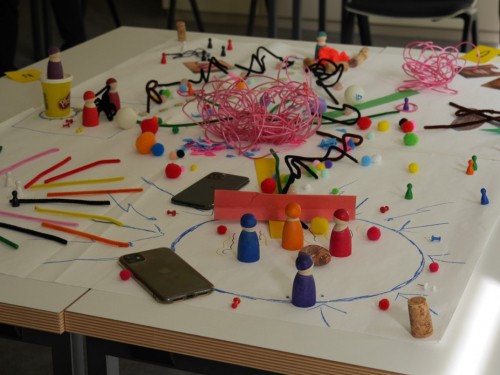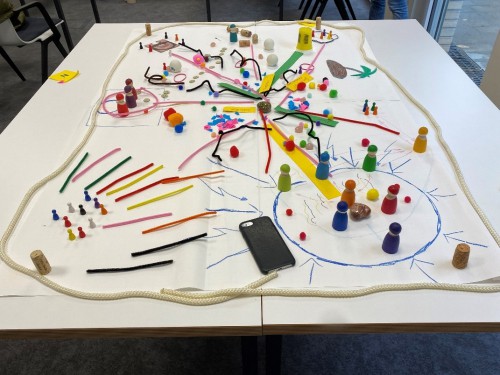15.06.2022
Ever heard of a conceptathon? Nope? No wonder. It’s actually a brand new format of New Work and New Learning that combines teamwork, collaboration and learning with immediately usable work results in the field of conception. And it does so with a lot of fun and a high level of energy. That’s what the Conceptathon is – a New Work Booster.
Conceptathon reminds of Hackathon
To be honest, the basic idea of the Conceptathon is not all that new. It has its roots in hackathons known since the turn of the millennium in hardware and software development.
These are IT developers meetings limited in time, first in the presence and later also in the virtual environment. They pursue the goal of collaboratively developing products or finding solutions to specific challenges during the meeting. From classic hackathons, the public is familiar with large quantities of pizza boxes and all kinds of technology that the developer needs to creatively design the tasks set. You could say they have made a reputation for themselves as mega pizza parties, where a lot of creative competition packed into agile sprints ensures a lot of fun and output.
Conceptathon has agile roots
And that’s where the Conceptathon comes in. This format also relies on collaborative design and a good team spirit to achieve high-quality work results in a short time. The Conceptathon also focuses on fun and creativity and the basic design is in sprints. So it is in no way inferior to the Hackathon and appreciates its qualities and experience. Especially since the Hackathon, as a prototype of agile working, practised the principles of New Work in its purest form early on.
Learning by doing in Conceptathon
And yet the Conceptathon is very different from its relative. That starts with the general conditions. It is true that the Conceptathon also offers suitable catering, but with a different focus: fresh fruit and snacks with food for the brain. Conceptathons are also planned for several days. The nights, however, are for regeneration and the breaks and evenings are for relaxing, often with the team. While at hackathons everything is preferably darkened, conceptathons deliberately open doors and windows and let the light in or move straight outside into nature.
The real difference, however, lies in the format itself. The Conceptathon – a New Work Booster – supplements collaborative learning and working with small teaching nuggets at the beginning and end of a sprint. I.e. during the meeting, the product development is supplemented with suitable learning impulses that then inspire the joint concept work. In this way, not only is something co-created, but at the same time a targeted individual competence development takes place.
As the name suggests, learning and working at Conceptathon revolves around the theme of “conception”. In many ways, a participant in a Conceptathon can increase his/her ability to create concepts while at the same time designing concepts.
This process is supported by these attitudes or methods:
- The idea of the “Wisdom of the crowd”, i.e. many people working together have a more holistic perspective and more options for finding solutions than just one person
- The New Work principles of “collaboration” and “co-creation“, the understanding and methods of how to effectively implement collaborative working
- The New Learning understanding that learning is best done by doing and on demand
- The approach that learning facilitators as guides, as we say at TCJG, give impulses that promote empowerment instead of imparting knowledge
- The framework of Design Thinking, which can be used not only for excellent product development but also for the development of concepts
Conceptathon – a New Work Booster
A conceptathon can be held over 2 days, but it is preferable to run it over 3 days. A longer duration is not recommended, as experience has shown that the concentration decreases.
Design of a camp that works with a team of 5-7 people and a guide is recommended. The number of participants is scalable with a simultaneous increase in the number of learning guides. This camp can also be significantly larger at any time if the framework conditions allow.
These conditions should be met:
- Sufficiently large room with individual working areas for each participant, but also collaboration areas and chill-out areas
- Provision of technical equipment (e.g. computers) and creative material
- Space or format that allows all participants to meet together from time to time during the course of the workshop
- Availability of healthy catering
- Offer socialising and team-building sessions
Conceptathons can be organised in fixed working teams or in Mix-Max groups. They are suitable for the “real world”, for example as presence camps and are recommended by us, but they also function just as well in the virtual world as remote sessions.
In order to test the ability to create concepts, suitable topics should be available. Either the participants themselves bring topics or the organiser provides appropriate topics and, if necessary, resources.
The design of a conceptathon can be varied. A pure open space is just as suitable as a theme-based format, such as the joint development of workshops or learning nuggets, or the creation of decision-making templates for new ideas of one department.
Either way, the Conceptathon is a New Work Booster. And a learning booster at that.
Many good reasons for a Conceptathon
The added value list of Conceptathons is as long as its possible applications.
Here are just a few selected reasons why Conceptathon – is a New Work Booster.
- Participants build up individual competences in the field of systematics and structure as well as expertise in concept work and agile working
- Collaborators experience community work and train collaboration with a view to output
- Participants experience teaching and learning at eye level and understand the importance of sharing and caring in the context of New Work
- Participants learn a variety of methods, e.g. design thinking or Scrum techniques as well as creative work and argumentation
- The investment in learning has an immediate effect: directly usable concepts for the utilisation of the learning process
The Conceptathon is an open source Zeitgeist L&OD format by The Company Journey Guides.
You shape the future.
This is something we´re good at.
This article was written by Eva-Maria Danzer.


